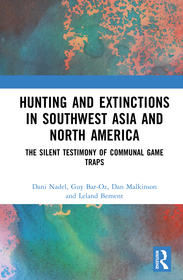
Hunting and Extinctions in Southwest Asia and North America
The Silent Testimony of Communal Game Traps
-
10% KEDVEZMÉNY?
- A kedvezmény csak az 'Értesítés a kedvenc témákról' hírlevelünk címzettjeinek rendeléseire érvényes.
- Kiadói listaár GBP 145.00
-
69 273 Ft (65 975 Ft + 5% áfa)
Az ár azért becsült, mert a rendelés pillanatában nem lehet pontosan tudni, hogy a beérkezéskor milyen lesz a forint árfolyama az adott termék eredeti devizájához képest. Ha a forint romlana, kissé többet, ha javulna, kissé kevesebbet kell majd fizetnie.
- Kedvezmény(ek) 10% (cc. 6 927 Ft off)
- Kedvezményes ár 62 346 Ft (59 378 Ft + 5% áfa)
Iratkozzon fel most és részesüljön kedvezőbb árainkból!
Feliratkozom
69 273 Ft

Beszerezhetőség
Még nem jelent meg, de rendelhető. A megjelenéstől számított néhány héten belül megérkezik.
Why don't you give exact delivery time?
A beszerzés időigényét az eddigi tapasztalatokra alapozva adjuk meg. Azért becsült, mert a terméket külföldről hozzuk be, így a kiadó kiszolgálásának pillanatnyi gyorsaságától is függ. A megadottnál gyorsabb és lassabb szállítás is elképzelhető, de mindent megteszünk, hogy Ön a lehető leghamarabb jusson hozzá a termékhez.
A termék adatai:
- Kiadás sorszáma 1
- Kiadó Routledge
- Megjelenés dátuma 2025. december 8.
- ISBN 9781032774510
- Kötéstípus Keménykötés
- Terjedelem398 oldal
- Méret 234x156 mm
- Nyelv angol
- Illusztrációk 101 Illustrations, black & white; 101 Halftones, black & white; 4 Tables, black & white 700
Kategóriák
Rövid leírás:
Hunting and Extinctions in Southwest Asia and North America explores communal game traps for harvesting ungulate herds in two continents, utilizing a comparative approach addressing settings, species and the hunters’ societies.
TöbbHosszú leírás:
Hunting and Extinctions in Southwest Asia and North America: The Silent Testimony of Communal Game Traps explores communal game traps for harvesting ungulate herds in two continents, utilizing a comparative approach addressing settings, species, and the hunters’ societies.
The kites of Southwest Asia have been known to archaeologists for almost one hundred years but with the advent of high‑resolution satellite images, thousands of sites have been found. Using the rich data from the Southwest and Central Asia and North America, this book addresses some of the important questions that arise concerning the social, economic and environmental implications of ancient and recent use of large game traps. This book has four major parts. The first introduces the book and reviews the evolution of human hunting. The second part presents examples of desert kites from various areas of Southwest and Central Asia. Detailed case studies are included that use a variety of evidence such as aerial surveys, field surveys, excavations, eye witnesses accounts, and petroglyph depictions. Environmental and geographical settings of the isolated traps, the clusters of traps, and the long chains are explored to provide conceptual models regarding past herd behavior and their seasonal migrations. The third part presents examples of communal game traps in various regions in North America, addressing the same issues discussed in the second part. The fourth part provides a comparative study of game traps in North America with the kites of Southwest Asia, focusing on the settings, species, and social organization of the hunters.
With the research on communal game traps increasing rapidly, this book provides the first inclusive synthesis on the subject and is for archaeologists, anthropologists, zoologists, ecologists, and environmentalists who are interested in past interactions between humans and their environments, and the impact of past human communities on the landscape and on target game populations, as well as the consequences that are still relevant today.
TöbbTartalomjegyzék:
Part 1: Introduction; 1. Introduction; 2. The Evolution of the Human Hunt; Part 2: The Kites of Southwest-Central Asia; 3. The Settings and Sources for Reconstructing Kite Use; 4. The Archaeology of the Kites in Southwest and Central Asia; Part 3: The Traps of North America; 5. The Settings and Sources for Reconstructing Trap Use; 6. The Archaeology of the North American Traps; Part 4: Discussion – Southwest Asia and North America; 7. The Ecology and Archaeology of Traps and Reconstructed Migration Models; 8. Social Aspects of Communal Hunting; 9. Past and Future
Több





